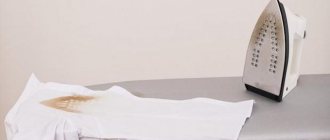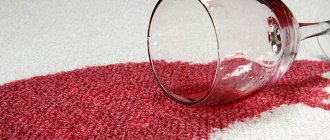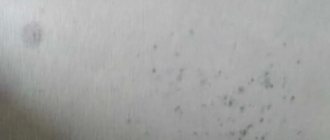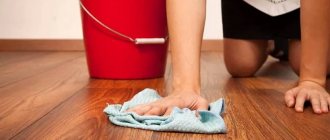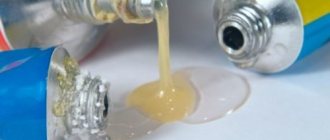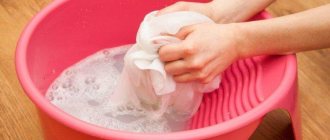How can you remove a wine stain?
When choosing a suitable product, you must take into account the type of fabric, otherwise you may not achieve good results and even ruin the item. If you are interested in how to remove a red wine stain, then use these recipes:
- Colored clothes. Combine the yolk, glycerin and a little water. Place the finished composition on a cloth and leave for 3 hours. After this, remove the stain and wash the item.
- White clothes. Immediately cover the stain with salt, then take a piece of lemon and rub it on the stain. After this you can wash the item.
- Natural silk and wool. Mix equal amounts of fruit alcohol and pharmaceutical glycerin. Wipe the problem area with the mixture, leave for three hours, then remove any residue and rinse under running water.
How to remove wine stains from a sofa?
The liquid is absorbed into the upholstery very quickly, so you should not hesitate if coloring alcohol has been spilled. There are several ways to remove a red wine stain:
- Wet the problem area and rub it with a bar of laundry soap. It is important not to use hot water, otherwise the problem will worsen. A sponge will help remove soap and excess moisture.
- If the first method does not work, then take an alcohol solution by mixing water and alcohol in equal proportions. Spread the finished mixture onto the stain and leave for a few minutes. At the next stage of cleaning, you need to wipe everything with dry wipes.
How to get rid of wine stains on wallpaper?
If you opened a bottle of wine carelessly and there are stains on the wallpaper, then you need to act quickly. It is important to first test the effect of the product on an inconspicuous piece of wallpaper, and then start cleaning. When figuring out how to remove red wine stains, we offer the following methods:
- Blot up the moisture and treat the stain with foamed dishwashing detergent or Vanish. Do not rub too hard to avoid damaging the surface.
- For light-colored wallpaper, chlorine-containing bleaches or regular toothpaste are suitable.
- If the stain is dry, rub it with an eraser or melamine sponge, but do not overdo it so as not to spoil the surface.
Wine stains on the ceiling
If the ceiling is covered with water-based paint or plaster, then you can use the following folk remedies: ammonia + salt, household stain removers and bleaches. They are all used according to the same scheme: you need to blot the contaminated area with a sponge soaked in the chosen product. If these options do not work and the question of how to remove wine stains remains relevant, then you can purchase a cleaning spray that can cope with stubborn stains.
How to remove a wine stain on a tablecloth?
Drinks often spill during a feast, and wine stains are one of the most problematic stains. The basic rules regarding how to remove wine stains include:
- You should try to blot the stain as quickly as possible and wipe it with a damp sponge. If possible, place several paper napkins under the contaminated area and place any heavy object on top. Thanks to these manipulations, all excess moisture will be absorbed. When the guests leave, soak the tablecloth in warm water with powder. After half an hour, wash it as usual.
- Wine stains can be removed with salt by first moistening it to form a paste. Place it on the problem area for half an hour, then wash with soap and rinse.
- A well-proven folk method involves the use of such a remedy: mix yolk and glycerin in equal quantities. Apply the mixture to the stain, leave for a while, rinse and machine wash.
Wine stain on carpet
If wine is spilled, then immediately blot it using a damp cloth, which is best pre-moistened in water. This makes cleaning easier. The diagram on how to remove wine stains from a carpet includes the following steps:
- Take a small piece of fabric that should absorb moisture well. Place it on the problem area and press firmly. Wait a few minutes for the material to absorb the remaining wine. Repeat the procedure if necessary.
- To prevent wine stains from remaining, use a hydrogen peroxide solution. Combine three parts water and part peroxide. First test the product on an inconspicuous area of the flooring to monitor the reaction. Apply a thin layer of the solution and blot the carpet with wet wipes.
How to wipe away an old mark
An old stain partially destroys the top layer of wallpaper, facilitating deeper penetration of pigments. Clean the coating quickly and carefully, not allowing the solution to completely saturate the material.
After cleaning, dry the work area with a paper towel or microfiber.
Facilities:
Soda will remove red wine stains from paper wallpaper. Wet the surface with a spray bottle, apply powder and remove after drying.
Traditional methods
Folk recipes remove fresh and old stains. The best remedy is citric acid. Mix powder with water in a 50/50 ratio. Rub the paste into the dirt, leave for 5 minutes and rinse.
Use hydrogen peroxide and laundry soap. Moisten the stain and blot with peroxide. Lather the sponge and treat the stain. Repeat until removed and rinse with water. On white surfaces, hot milk or whey will help.
Household chemicals
Use household stain removers and concentrated cleaning products. Apply undiluted or prepare a working solution and apply to the surface with a cloth rag. Leave for 5-7 minutes. Wipe the wallpaper with a dry cloth or paper towel.
If the wine stain is stubborn, increase the exposure time to 10 minutes.
Household chemicals:
Consider the type of material when cleaning wallpaper. Be careful where two sheets meet.
How to remove red wine stains
How to remove a red wine stain when there are no special products available? Simple products found in every kitchen will help with this.
- Vinegar. 9% table vinegar will help remove traces of red wine on clothes. It is poured onto a section of fabric, left for no more than 20 minutes, and then the item is washed as usual. If you do this immediately after the stain appears, then a positive result is 99% guaranteed, even on white clothes.
- Boiling water. This method can also help remove red wine stains, but only if the stain is very recent. The stained area must be doused with boiling water until the traces of wine disappear.
- Salt and lemon juice. If you rub the area with the stain with a mixture of lemon juice and salt, then rinse and wash, there is a high chance that it will completely disappear.
- Vodka. This product will help remove even old stains. Using a swab dipped in vodka, treat the contaminated area of the fabric, then rinse and wash as usual.
Useful tips
- It is better to start working with the stain from the inside out. Taking a test will also be helpful.
- Stain removal always begins in the direction from the periphery of the contaminated area to its center.
- Before starting work, it is more convenient to arm yourself with a board as a substrate. It can be covered with several layers of clean light material.
- If the origin of the stain is unknown, it is easiest to treat it with universal means: salt or ammonia.
- It is better to wash the item pre-treated with the “emergency remedy” by hand, with preliminary soaking.
- Before removing the stain from the surface of the material, it is better to thoroughly clean it with a brush: dry, and then wet.
Removing stains from white items
Many people wonder how to remove wine stains from white clothes at home?
Let's look at several popular methods.
Store funds
Wash stains from white fabric with Antipyatin soap, which is used to thoroughly treat and rinse the clothes several times.
Many women recommend washing red wine from white clothes with Vanish bleach. Recommendations are indicated on the packaging.
Baking soda
Baking soda and baby laundry detergent will help remove wine from white items.
Mix the ingredients with heated water and treat the desired area. You can clean it with an unnecessary toothbrush. Then we wash it in the usual way.
Milk
How to remove red wine from white using milk or curdled milk?
Fill a separate bowl (basin) with warm milk, dip the damaged part of the fabric into it, soak it overnight, and rinse in the morning.
Types of wallpaper and features of their washing
There is no universal remedy or method that could wash all types of wallpaper. For each type of wall covering, it is necessary to select the appropriate cleaning method. Let's look at the most popular, common and popular types of wallpaper, as well as methods for washing them.
Paper wallpaper
This type is good because its cost is the lowest compared to other varieties with a large selection of colors and patterns. However, paper is capable of perfectly absorbing any contaminants, the removal of which can become a real problem. You can wash paper wallpaper from stains and marks in the following ways:
Important! Before using one of the above methods, you should test it in an inconspicuous area, for example: behind furniture or behind a door.
Natural wallpaper
Contaminants from natural wallpaper are removed exclusively using a dry method. Especially for this type of surface, feather brushes are available for sale to remove dust. Due to the presence of a protective layer on natural wallpaper that repels dust, washing them is strictly prohibited.
Vinyl and non-woven wallpaper
Unlike paper wallpaper, non-woven and vinyl wallpaper is washable, and washable wallpaper can be washed with less danger than paper wallpaper. However, each of them has its own cleaning methods, which are indicated by the manufacturer on the roll label in the form of special markings.
Marking
Washing method
Procedure for cleaning non-woven and vinyl wallpaper at home:
Important! When using the wet method of washing wallpaper, you should not allow it to get too wet, as the material may tear or peel off.
Working with thin fabrics
Some fabrics require very careful handling. This applies to dresses made of silk and delicate knitwear. They require a special approach. If you need to quickly remove red wine stains on thin materials, the following methods will help:
- It is enough to mix medical alcohol and glycerin (1:1), and then treat the stain with the composition. Let the clothes sit for 2-3 hours. Then you just need to wash it.
- It is necessary to make a solution based on ammonia, alcohol and laundry soap. The components are diluted in warm water. You just need to wet the stains and let the clothes sit for a while.
- For silk, nylon, nylon, a different composition is suitable. Use warm water (100 ml), liquid soap (15 ml), alcohol (30 ml). You also need ammonia (a couple of drops). The product can be applied to dirt. If the stain has not been removed, repeat the procedure. It is necessary to eliminate the residues, after which the product can be rinsed.
Features of removing fresh and old stains
Stains from red wines are classified as tannin-containing, although in addition to tannin (tannin), they include the coloring matter anthocyanin. Such contaminants tend to eat into the material over time. Therefore, to effectively remove stains, it is important to know their “age”.
Fresh stains are easier to remove even with simple products: soap, soda or washing powder. Old, ingrained ones require more effective chemical compounds. However, here it is important to correctly assess the consequences of their impact on the structure and color of the fabric. To do this, before removing a red wine stain, especially an old one, carry out a test by wiping it with a chemical agent in an inconspicuous place of the item.
When using a particular solvent, its possible destructive properties are taken into account:
In addition, the use of alkalis and bleaches is only permissible for the purpose of processing white materials.
Removing an old stain begins with cleaning the item from dust, knocking it out and brushing it. Then they try to remove it by deeper cleaning with a soap solution and if the stain remains, they use chemicals, from weaker to stronger, with rinsing with clean water after each procedure.
You should first try to remove fresh stains by repeatedly washing the fabric, first with cold and then with hot water. Afterwards, you need to clean it with a toothbrush or cloth soaked in a warm soapy solution, and only then rinse in clean water and dry.
Important! It is very risky to use highly concentrated solutions - it can irreversibly damage the item. Instead of a strong product, it is better to remove the stain in several approaches using treatments with a weaker composition.
You can also use a cotton swab to clean the stain. First, wet the area around the stain, and then move towards the center of the stain. This order is needed so that it does not blur and does not form streaks. For the same purpose, the stain halo can be treated with gasoline, talc, and starch. This applies to large contaminants. For small spots, apply the solution with a pipette or a wooden stick.
How to remove an old red wine stain
It is not easy to remove old red wine stains without a trace using conventional means: you will have to make an effort and try.
For example, using citric or oxalic acid in a solution of 2 g of the substance in one glass of water, followed by rinsing under a warm running tap, can remove an old red wine stain.
The choice of method for removing contamination will depend on the type of material.
In severe cases, you can remove the stain using a radical recipe: liquid soap, ammonia, turpentine in a ratio of 10:1:1. The stain is thoroughly treated with the composition, and then washed with warm soapy water.
A solution of citric acid on a cotton swab, which is used to thoroughly wipe away alcohol stains, can help deal with old red stains on fabrics. The procedure is repeated until the stain completely disappears.
It is important to understand that red stains from wine are difficult to remove, since the drink tends to be well absorbed into the fibers, and if you do not apply the means to eliminate it in time, you can lose the item (usually an elegant one). Removing fresh stains is a simpler procedure than getting rid of deeply absorbed and, especially, dried stains.
How to remove a fresh red wine stain
Fresh red wine stains can often be removed by regular washing with soap, baking soda or other detergents.
Oddly enough at first glance, boiling water is the easiest way to remove a fresh red wine stain for natural cotton and linen fabrics. The material is stretched onto a metal dish, for example, a pan, and poured with boiling water in a small stream. For effectiveness, add citric acid or any vinegar to it.
Attention! This method is more suitable for light-colored materials and is not at all useful for delicate fabrics, which are recommended to be washed at temperatures up to 40 oC. A test is carried out before use.
Perhaps the most popular folk remedy is fine table salt: it is lightly soaked in water and the resulting slurry is sprinkled on a cloth. The exposure is several minutes until the pigment is absorbed by the crystals. If necessary, repeat the procedure, and then carry out normal washing.
How to clean dirt
Before deciding how to clean wallpaper, you need to determine what type it is, since each type requires a different cleaning. The easiest way to clean washable wallpaper is; at home they can be washed with soap. The moisture-resistant top layer prevents liquid from penetrating into the structure. Relatively easy to clean paper-based vinyl.
Therefore, it is easier to remove stains from white wall coverings.
Important! The methods below do not guarantee 100% success. In case of some contamination, it may still be necessary to replace the wallpaper (or parts thereof) with new ones.
Methods used to eliminate contaminants are divided into:
- chemical (using acids, alcohols, cleaning agents);
- folk (use of home remedies).
General cleaning rules:
- When contaminated with liquid, it is important to absorb it from the surface as quickly as possible. This is important if you want to wash off wine stains and fruit juices.
- When cleaning paper surfaces (both colored and white), use dry cleaning rather than wet cleaning.
- Do not use chlorine bleaches or abrasives (even during demanding post-renovation cleaning) - they will clean the surface, but at the same time damage it.
- It is best to clean the surface from dust with a vacuum cleaner - a rag can lead to “rubbing” dirt into the fibers or paper, disturbing the color, pattern, and structure of the wall covering.
- It is unlikely that you will be able to wash red wine and some juices (especially from tomatoes and pomegranate) from paper or fleece coverings. In most cases, the damage is irreparable.
Folk remedies
Before using any cleaning product, remove dust and dirt from the surface to be cleaned - this will prevent stains from appearing.
To clean wallpaper from dirt, you can use the following substances:
- Soap solution. You can use it to wash vinyl wallpaper, liquid wallpaper, and detergent wallpaper in the kitchen.
- Bleach. Suitable for removing stubborn dirt from wallpaper (get rid of felt-tip pen, permanent marker).
- Melamine sponge. Helps remove most stains. Not suitable for paper or non-woven wallpaper.
- Bread. Capable of cleaning paper wallpaper (see application below).
- Alcohol based products. Alcohol removes the most stubborn stains, such as dried glue, and can wash off grease and rid walls of iodine, plasticine and other contaminants.
- Tooth powder + refined gasoline (1:1). Helps you get rid of fat. The paste is applied to the stain and removed after drying.
- Wet wipes. Ideal for vinyl flooring.
How to remove red wine from all other wallpapers
Some types of wallpaper cannot be washed, but there are some tips on how to remove wine stains from paper wallpaper.
If the above methods did not help, and you do not know how to remove a wine stain from wallpaper, there is only one correct solution - replace the piece with the annoying blockage. You should have leftover wallpaper. Cut out the stained area and glue a piece of wallpaper in its place. If after renovation you prefer to get rid of unnecessary lumber and throw away all the remnants of wallpaper, pin a beautiful picture in place of the stain - it will refresh the interior and the wine stain will not be visible.
Editor's Choice
The orchid disappears, the leaves wither, and it blooms. What to do?
The user of the Woman.ru website understands and accepts that he is fully responsible for all materials partially or fully published using the Woman.ru service. The user of the Woman.ru website guarantees that the placement of materials submitted by him does not violate the rights of third parties (including, but not limited to copyrights), and does not damage their honor and dignity.
The user of the Woman.ru site, by sending materials, is thereby interested in their publication on the site and expresses his consent to their further use by the owners of the Woman.ru site. All materials on the Woman.ru website, regardless of the form and date of publication on the site, can only be used with the consent of the site owners.
Use and reprinting of printed materials from the woman.ru website is possible only with an active link to the resource. The use of photographic materials is permitted only with the written consent of the site administration.
Posting intellectual property objects (photos, videos, literary works, trademarks, etc.) on the woman.ru website is permitted only to persons who have all the necessary rights for such posting.
Copyright (c) 2016-2021 Hirst Shkulev Publishing LLC
Online publication “WOMAN.RU” (Zhenshchina.RU)
Certificate of registration of mass media EL No. FS77-65950, issued by the Federal Service for Supervision of Communications, Information Technologies and Mass Communications (Roskomnadzor) on June 10, 2016. 16+
Founder: Limited Liability Company "Hirst Shkulev Publishing"
Editor-in-Chief: Voronova Yu. V.
Editorial contact information for government agencies (including Roskomnadzor):
Dealing with traces of wine: common mistakes
When fighting pollution, it is important to avoid the following incorrect actions:
- Use aggressive cleaning agents to clean items made from delicate fabrics. Delicate matter can simply dissolve when exposed to an aggressive substance. It is not recommended to use chlorine-containing substances, recipes with turpentine, citric acid for washing silk blouses or natural wool carpets.
- Apply the stain remover immediately at the site of contamination. If possible, the stain should be thoroughly soaked in water so that it does not dry out, and in the meantime, test the effect of the substance in some inconspicuous place.
- Rub the stain with a dry cloth. If you start rubbing the stain, it will spread across the surface and become deeper.
- Procrastinate with removal. As soon as the wine has spilled, you should cover the stain as quickly as possible so that it does not spread. Then you need to find something that will be convenient to remove the red wine stain.
When fighting a stain, you can resort to different means. It may not be possible to completely remove an ugly blot. In this case, you should contact specialists. Modern dry cleaners are able to destroy even very stubborn stains and restore freshness to soiled items, so you shouldn’t waste money on this.
Difficult spots
You can remove ballpoint pen and ink from wallpaper, as well as other heavy stains, using one of the store-bought or popular cleaning products. Ways to remove difficult stains:
Traces of children's creativity
Drawings made in pencil can be easily removed with an eraser. It is also capable of removing wax crayons from wallpaper. As for felt-tip pens and markers, such masterpieces can be removed with soapy water. You can remove alcohol marker from wallpaper with alcohol or lemon juice.
Grease from paper wallpaper can be removed with starch, baby powder or talcum powder. To clean wallpaper, you can use a soap solution.
Red wine and blood
You can only remove blood or red wine from wallpaper by removing the old coating, soaking it with water and scraping it off. Then, instead of them, you should carefully glue a new piece so that the patterns match.
How to get rid of various stains?
Vinyl and non-woven products respond much better to detergents , as they do not allow moisture to penetrate deep into the material. The situation is more complicated with paper wallpaper, the structure of which is very easy to damage.
Read more information about wallpaper here, and you can find out more about ways to get rid of stains on wallpaper in this article, and about cleaning wallpaper and removing the old coating, read here.
Pencil
- Traces of a simple pencil can be removed with an ordinary soft office eraser. Do not rub the wall too quickly and vigorously, as this can damage the wallpaper pattern.
A good alternative to an eraser can be a melamine sponge, which can cope with marks not only of a pencil, but also of ballpoint pen paste. We talked about ways to remove pens from wallpaper here.
As a rule, it is much more difficult to wipe off traces of colored lead. The depth of the lines also complicates the process: the more pressure you put on the pencil, the more difficult it is to get rid of it without a trace.
The folk method offers a way to solve the problem using a warm hard-boiled egg. Cut it in half and apply it to the problem area so that the stain is absorbed into the pulp of the egg.
- For textured finishes, you can try the toothbrush method. Dilute the washing powder with a small amount of warm water, apply the mixture in a circular motion to the dirty area, and after a few minutes, gently scrub the surface with a brush.
Felt pen
- In order to get rid of art created by felt-tip pens and water-based markers, just soak a cotton swab in hydrogen peroxide and gently work the surface until completely clean. Move from the edge of the stain to the center so as not to smear the felt-tip pen on the wallpaper.
- To remove stains from alcohol markers, you can use tampons soaked in ethyl or ammonia. Another way: wipe the dirty area with a mixture of alcohol and lemon juice in equal proportions.
Wax pencil
Traces of wax pencil are easily removed by heating.
How to remove fresh drops of wine
The technology for removing contaminants consists of three operations: preparation, washing and drying. At the preparatory stage, prepare a cleaning solution. Check the reaction of the material in an inconspicuous area of the finish (behind the furniture). After cleaning, wipe the surface with a clean, dry cloth. Leave the wallpaper to dry.
Don't rub the cleaning solution in; just apply it to the material. When wiping the stain, move your hand from the edge to the center or it will spread heavily across the coating. Large volumes of water will leave streaks, so do not wash away any remaining wine with copious amounts of liquid.
Methods for cleaning non-woven, vinyl, bamboo wallpaper:
On paper wallpaper, use bread crumb. Blot the stain; the bread will absorb the liquid. On this type of finish you can use a melamine sponge.
How to withdraw using improvised means?
The use of improvised means to remove stains should take into account what type of wallpaper was used. Not all of them can be moisturized, much less washed. Information about the care and quality of the material can be gleaned from the label attached to the roll.
Simple remedies will help you remove stains
- hydrogen peroxide;
- alcohol;
- White Spirit;
- ammonia;
- refined gasoline;
- school eraser;
- water;
- heating with an iron to remove greasy marks, etc.
The method for cleaning wallpaper from stains depends on the type of contamination.
Tips and tricks for removing stains
You should always start removing a red wine stain by removing excess liquid. Wine contains natural dyes that are difficult to wash off, so take measures to wash it off as quickly as possible before the liquid is absorbed into the structure of the fabric. First of all, we soak the fabric with a napkin or cloth, and only then we begin to use folk remedies.
Important! The choice of stain removal product directly depends on the type of fabric. Traditional cleaning recipes that are used for other purposes can ruin the item.
To prevent the stain from spreading throughout the fabric, treatment is carried out from the edge to the center. It is not recommended to treat fabric with hot water; on the contrary, this method can stain the fabric more permanently.
If traditional methods are ineffective and the item is of high value, use the services of professional dry cleaners.
